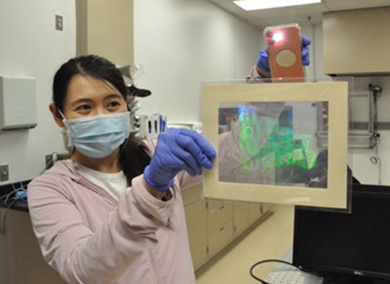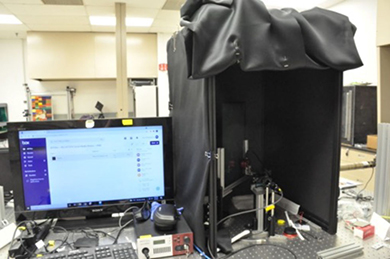How Does a Hologram Age? New Approaches to Documentation
Machine learning models help stitch together multiple perspectives on a hologram, allowing for digital reproduction
Analog holograms present a puzzling challenge for media conservators and historians. The floating, flickering, seemingly immaterial qualities that make them compelling as art objects are also what make them difficult to understand as material—material which requires interaction to view and which degrades over time. So what is one preserving in an analog hologram?
Holograms are formed from light, from a laser beam that’s split into a reference and an object beam. As the object beam illuminates the subject, the light scatters and interferes with the reference beam. This interference pattern is recorded on a photosensitive material like film or photographic emulsion. The 3D-image of the subject is generated when the hologram is illuminated with a reference beam like the original and the interference pattern diffracts the light. Like photographs and other light-sensitive media, the emulsion is subject to change over time—but it is difficult to document those changes to the surface without interacting with more light.
 Researchers at the Center for Scientific Studies in the Arts have been testing methods of digitally preserving analog holograms. They worked with the Massachusetts Institute of Technology Museum to experiment with techniques for documenting their collection of analog holograms from the Stephen Benton collection. Benton (1941-2003) was a prolific holography artist who saw the medium as a way of combining art and technology—thus the use of contemporary imaging and machine learning techniques is a fitting legacy for engaging with these unusual media.
Researchers at the Center for Scientific Studies in the Arts have been testing methods of digitally preserving analog holograms. They worked with the Massachusetts Institute of Technology Museum to experiment with techniques for documenting their collection of analog holograms from the Stephen Benton collection. Benton (1941-2003) was a prolific holography artist who saw the medium as a way of combining art and technology—thus the use of contemporary imaging and machine learning techniques is a fitting legacy for engaging with these unusual media.
They used noninvasive analytical techniques such as spectral imaging, X-ray fluorescence, and optical coherence tomography, to provide insights on hologram material properties. Researchers experimented with processes for faithfully capturing aspects of the hologram such as the high spatial resolution, the full parallax, and deep depths of field—all qualities that make the medium distinctive yet hard to capture fully as a reproduction.
The goal is not to produce an exact copy of the hologram—that would require digitizing every nanometer-spaced fringe on the material surface—but rather to document multiple perspectives and train a machine learning model to render a digital version of the image. Neural Radiance Fields (NeRF) is a machine learning-based rendering technique that draws from prior computational optics work in synthesizing multiple camera perspectives of a 3D scene, using a limited set of 2D photographs.
 Broadly described, the documentation process involves illuminating the hologram at the correct playback angle with a coherent light source, then moving a camera to capture multiple viewpoints in a hemispheric span. These samples provide training for the machine learning model to render the views into a “seamless” viewing experience of the digitized hologram. Researchers tested the documentation method with Benton’s Engine no. 9 hologram, capturing 18 different images of the hologram with a DSLR camera mounted on a gantry. Initial tests have indicated future directions for study in refining and replicating the technique with other hologram material.
Broadly described, the documentation process involves illuminating the hologram at the correct playback angle with a coherent light source, then moving a camera to capture multiple viewpoints in a hemispheric span. These samples provide training for the machine learning model to render the views into a “seamless” viewing experience of the digitized hologram. Researchers tested the documentation method with Benton’s Engine no. 9 hologram, capturing 18 different images of the hologram with a DSLR camera mounted on a gantry. Initial tests have indicated future directions for study in refining and replicating the technique with other hologram material.
Publication:
Choi, J., A. Dashpute, B. Xu, O. Cossairt, M. Walton, J. Tumblin, F. Willomitzer. 2023. "How to Archive the Visual Contents of Aging Analog Film Holograms?" Deutschen Gesellschaft für angewandte Optik conference proceedings, 124.
